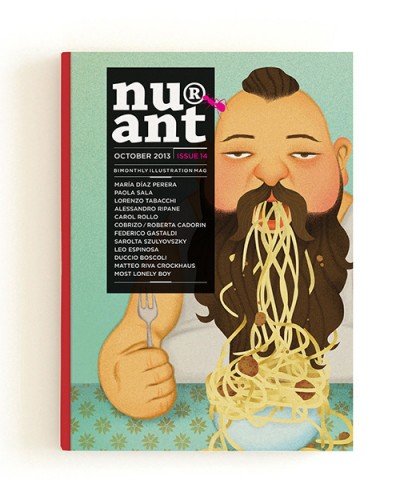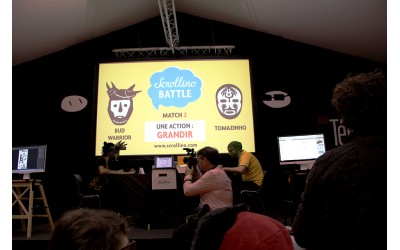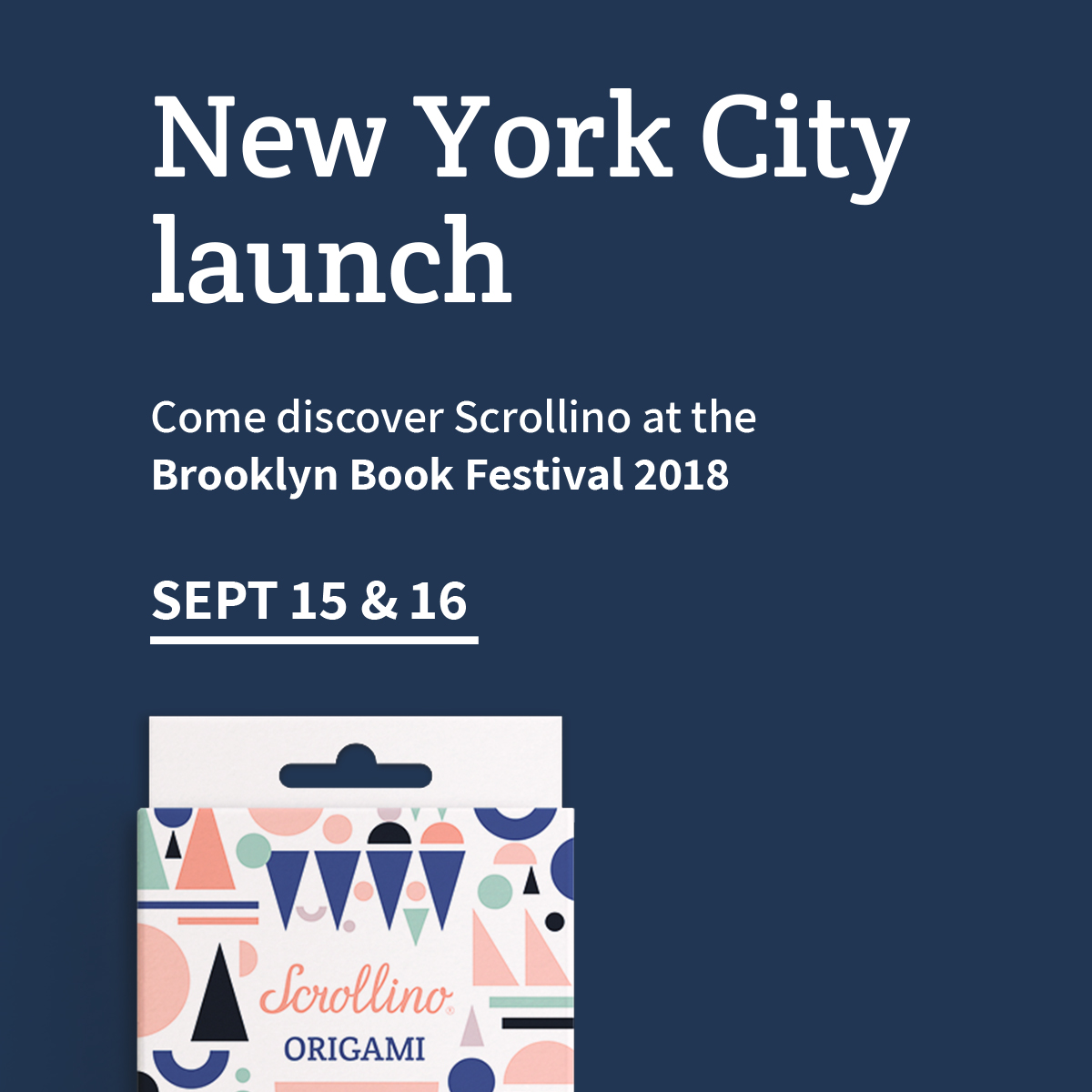About connecting images and exceptional views with Lasse Wandschneider
Illustration by Lasse Wandschneider: How would you draw edition lidu
Lasse, you were our first guest speaker of the de.sign5 lecture series in Prague, you talked about the connection between illustration and graphic design, what is the biggest challenge in your work?
I would say the biggest challenge is to find a balance between developing my own artistic vision and making a living off it. There wouldn't be much use in putting my heart and soul into something and then selling out to some big company, although that's where the money is. I want to be able to keep a critical attitude toward the system I have to work in and that no one can escape. And selling yourself as a sort of brand has become very important, but it holds the danger of losing sight of your own vision, and I think the commercial aspect of being an illustrator is the biggest struggle for me right now. But everybody has to deal with that, and there are a lot of cool projects, right now I am making illustrations for an exhibition in a museum about ships and sailing, I would love to do more jobs like that in the future!
What do you like the most about illustration?
To me, illustration is always a form of interaction: in the literal translation it means enlightening or explaining something, so it is clearly a reaction to something...it can be a visualization of a scientific situation, or an addition to a piece of literature or music, or it can also take a more independent stand and express the illustrators own interpretations of and reactions to the world around us.
In any case, illustration can offer us a broader understanding of many things and a different approach of looking at this world, just like any other art form it can at least give you an idea of an alternative to our reality.
I also love that drawing or illustration is so accessible, for the audience as well as the makers, almost everybody has been drawing at one point in their life, and you need almost no material to start with, so a lot of people can somehow relate to a drawing in a book more than to a piece of art in a gallery, and a book is also much less exclusive (and probably more affordable). Illustration is almost always meant to be reproduced, that means it can reach a broader audience and is more openly accessible than a lot of other art forms in my opinion.
You created completely new works for the exhibition in Prague, where you influenced by the particular space, city or time?
I was definitely influenced by the space: The rooms for the exhibition were really big with high ceilings, so I wanted something colorful or more large-scale than my usual drawings (which are normally quite small), and I decided that screen-printing pictures with a lot of different colors and in different sizes would be a good way to handle this room. For the content of the pictures I was looking through my sketchbooks and recent drawings, but there are no specific topics and no theme for the exhibition, I just wanted to give an impression of what I was working on or thinking about at the moment.

Ludmila Favardin (edition lidu) with Lasse Wandschneider in the exhibition in Goethe Institute Prague
And how did you come up with the super long title of your solo show in Prague?
I was trying to find an explanation of how I see my own work and of presenting it in an exhibition. A park is connecting culture and nature, it means arranging and giving a shape to something that has a life of its own. It's a presentation, people can look at it and walk through it and hopefully enjoy it, too. And making the title so long was just fun for me, and making it more interesting, just calling it “park” would have been quite boring, right? Maybe I wanted a title that doesn't take itself too seriously.
As a part of the de.sign lectures, you also illustrated the front page of A2 cultural journal that is printed in 2 colors only (black and orange). Do you like technical limitations?
Limitations help a lot! I am always glad when I have a certain set of boundaries to begin with. It helps me to focus and maybe also to come up with a more creative or unexpected solution. For example, I often determine the grid of a comic before I start drawing, and if I want to include a table and a person and a dog all in one panel, I might have to squeeze them in there in a different way than I would if I had a whole blank page before me. So by limiting the space I am forcing myself to think more about it and be more careful with it. Like with improvisation in music maybe, the rules are a guideline and give meaning to the content, and become an important part of it.
And technical limitations are always there in some way, so for me it makes sense to know them before you start working, to avoid disappointments and to get a better result in the end. Of course it makes a big difference if the picture is to be printed in two colors like the cover of A2, or if it is for online use, or a lino-cut...

Illustration by Lasse Wandschneider for A2 Newspaper realized within de.sign lecture series 2015
How did you enjoy Prague?
During the exchange semester in Prague I felt a lot of energy to try out new things and work more freely, I think it always helps to have a complete change of surroundings to focus on drawing and to be more open to take in what's surrounding me, and I think Prague had a very big impact on my work, both with the rich Czech history of illustration and as a personal experience at a different school, meeting new people, seeing how they work and making friends here. So I have a lot of positive associations, and I felt that when I came back for the exhibition!
Your pictures have often (probably always) more levels of interpretation. Do you think of all of them during the creative process, or do you discover new meanings even later when you look back on your images?
I am very bad at planning anything when I'm drawing! I start with a certain idea, and often end up somewhere completely different in the end, and in the process new ideas often come out of my hands rather than out of my mind. That makes sense, because drawing is a different way of thinking for me, and it would be pretty boring to only draw what was in my head first, that would take away all that makes drawings such a rich source of new ideas. So I like to be surprised by my drawings and could never rely only on my rational mind alone to create something worth looking at.

Illustration by Lasse Wandschneider from small comics for Tiny masters - Leipzig based publishing project
During your lecture in Prague, you also talked about comics. Do your books have superheroes? And do you?
No, I don't remember any superheroes in any of my comics...maybe somewhere you can catch a glimpse of someone who might be a superhero, but in most of my comics I don't even follow the characters long enough to see if they have any superhero-potential. The comics I make often don't have a plot, I am more interested in what kind of information or atmosphere you can get across by combining images on a page, telling something on a different level than it is possible in a single picture or in a piece of literature. From my German perspective I think it's too bad that this potential of comics is often not valued enough, and that comics are not seen as a serious independent art form. There is this big trend of marketing the more 'serious' comics as 'graphic novels', which might make them seem like some weird sort of literature with lots of pictures in it. I think comics is not a mixture of fine arts and literature, just like film is not a mixture of theatre and photography, but an independent form of art with its very own ways of bringing something across. And I think it will take some time to change this perception, but looking at countries like France where they call comics the 9th art, I think there is hope. And there is so much happening in this field right now! Comics are still at a point where a lot of development is possible, and many people put a lot of energy into exploring it and making so much great work, if I have any comic superheroes, it's definitely those artists!

Illustration by Lasse Wandschneider, personal project
I love your picture books Allem Anschein and Through the Forest, could these books be called comics?
It's not easy to draw a clear line around what is comics and what is not, but Through the Forest definitely has a lot of narrative elements and little stories told through images and text, so it's definitely a comic, whereas Allem Anschein has almost no text in it, and the images are page-filling and only very loosely connected, but I think it can still work as a comic, it just depends on the definition and how much effort you want to put into looking for what happens in between the pages/panels/pictures, I think that's what makes a comic, opening up that space 'in-between' and activating the viewer's mind.
What printing techniques do you use? Do you prefer hand drawing or working on the computer?
I always start drawing by hand, and I almost always use a computer later in the process, so it's mostly a balance between the two. But as I said earlier, I enjoy that drawing can be so simple, just pencil and paper, so that will always be the base for me. But take the exhibition at Goethe-Institut for example: Arranging and resizing drawings and preparing them for the screen-printing, you have a lot more possibilities with the computer, and it would make no sense not to take advantage of them. And computers help not only with the production but also with the distribution of images, it's so much easier to show your work online, and get people to see it and to see other people's work! In the end I don't see such a big difference, the computer is just another tool, or multiple tools, all in one heavy box that needs electricity, but very useful.
But I also enjoy other manual printing techniques, I am actually planning a series of etchings right now, and the computer will only be there to play music in the background.

Detail of the print exhibited in Prague, Illustration by Lasse Wandschneider, 2015
What else are you looking forward to at the moment?
I will be back in Prague at the end of September (2015), showing some pictures at the LUSTR illustration festival! It's another big room, and this time I am planning to show even bigger pictures, let's see how this works out. I also want to start working on an animation with a friend for a music video, it will be exciting to experiment with a different medium.
Speaking of experiments, I will also be part of edition lidu's series of Pocket Comic Books, where you publish comics in a very unusual way!
Thank you Lasse!
Interview by Ludmila Favardin
Photo credits: edition lidu and the archive of Lasse Wandschneider, Portrait photo by Marijn Degenaar
See photos from Lasse Wandschneider´s solo exhibition Exceptional views of a park-like Environment
Read more about de.sign lecture series 2015 curated by Ludmila Favardin






























